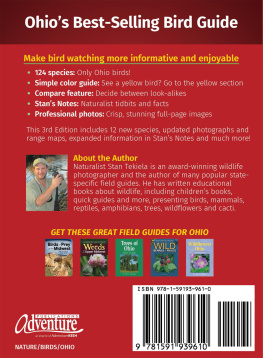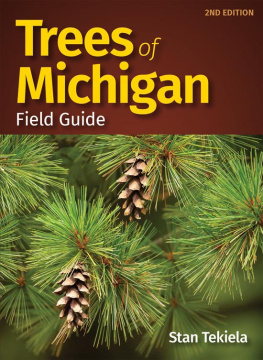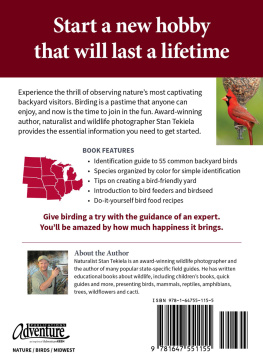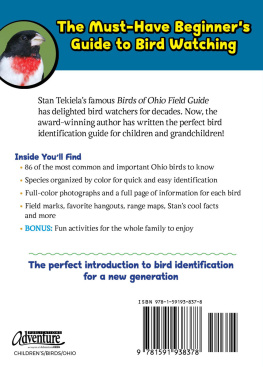
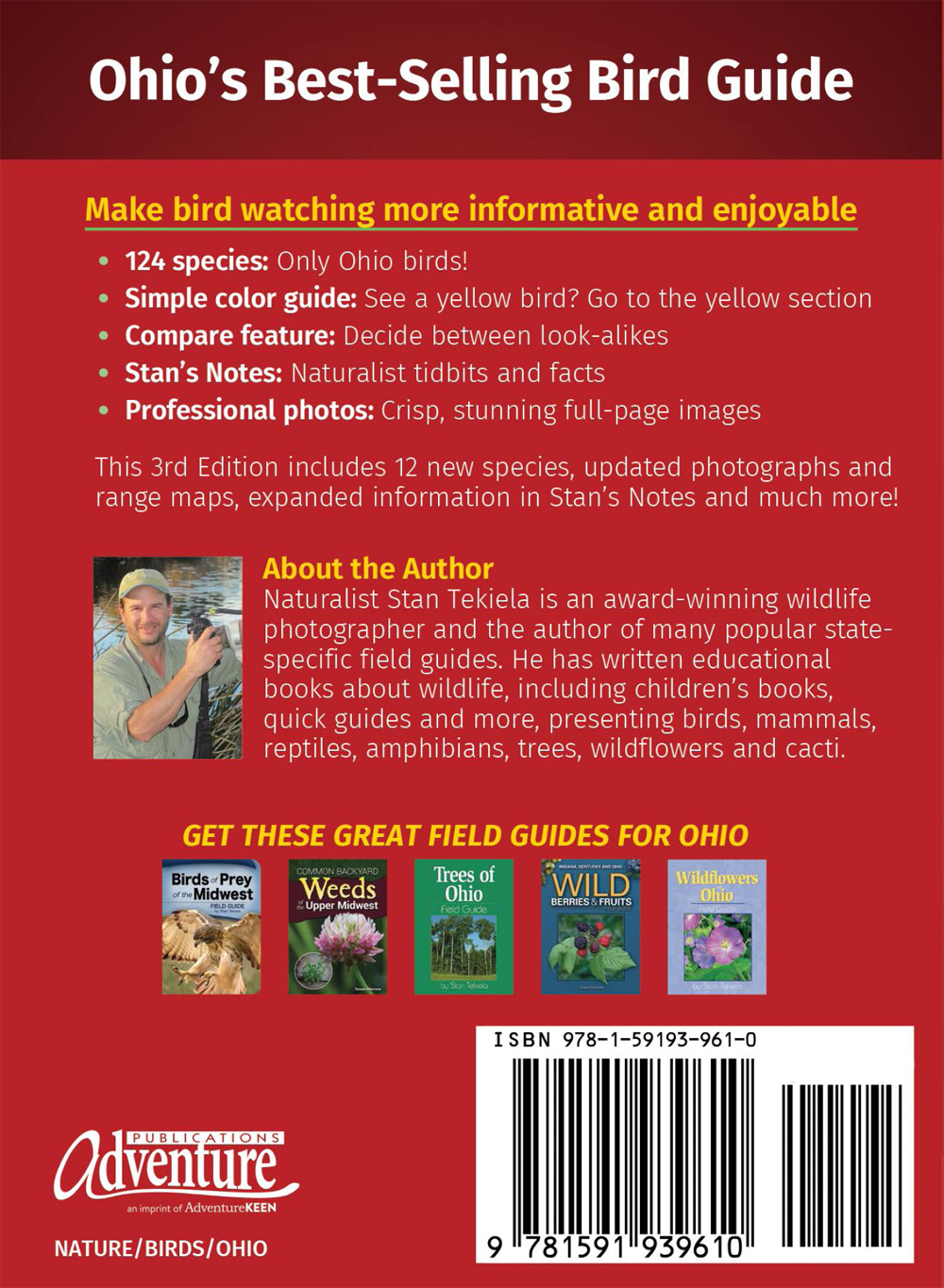

Edited by Sandy Livoti, Brett Ortler and Kate Johnson
Cover, book design and illustrations by Jonathan Norberg
Range maps produced by Anthony Hertzel
Cover photo: Blue Jay by Stan Tekiela
All photos by Stan Tekiela except (female) by Jim Zipp
To the best of the publishers knowledge, all photos were of live birds. Some were photographed in a controlled condition.
10 9 8 7 6 5 4 3 2 1
Birds of Ohio Field Guide
First Edition 1999
Second Edition 2004
Third Edition 2020
Copyright 1999, 2004 and 2020 by Stan Tekiela
Published by Adventure Publications
An imprint of AdventureKEEN
330 Garfield Street South
Cambridge, Minnesota 55008
(800) 678-7006
www.adventurepublications.net
All rights reserved
Printed in China
ISBN 978-1-59193-961-0 (pbk.); ISBN 978-1-59193-962-7 (ebook)
Dedication
To my wife, Katherine, and daughter, Abigail, with all my love
Acknowledgments
Many thanks to the National Wildlife Refuge System along with state and local agencies, both public and private, for stewarding the lands that are critical to the many bird species we so love.
TABLE OF CONTENTS
WHATS NEW?
It is hard to believe that its been more than 20 years since the debut of Birds of Ohio Field Guide. This critically acclaimed field guide has helped countless people identify and enjoy the birds that we love. Now, in this expanded third edition, Birds of Ohio Field Guide has many new and exciting changes and a fresh look, while retaining the same familiar, easy-to-use format.
To help you identify even more birds in Ohio, I have added 12 new species and 153 new color photographs. All of the range maps have been meticulously reviewed, and many updates have been made to reflect the ever-changing movements of the birds.
Everyones favorite section, Stans Notes, has been expanded to include even more natural history information. Compare sections have been updated to help ensure that you correctly identify your bird, and additional feeder information has been added to help with bird feeding. I hope you will enjoy this great new edition as you continue to learn about and appreciate our Ohio birds!

WHY WATCH BIRDS IN OHIO?
Millions of people have discovered bird feeding. Its a simple and enjoyable way to bring the beauty of birds closer to your home. Watching birds at your feeder and listening to them often leads to a lifetime pursuit of bird identification. The Birds of Ohio Field Guide is for those who want to identify the common birds of Ohio.
There are over 1,100 species of birds found in North America. In Ohio alone there have been over 430 kinds of birds recorded through the years. These bird sightings were diligently recorded by hundreds of bird-watchers and became part of the official state record. From these records, I have chosen 124 of the most common birds of Ohio to include in this field guide.
Bird-watching, often called birding, is one of the most popular activities in America. Its outstanding appeal in Ohio is due, in part, to the states unusually rich and abundant birdlife. Why are there so many birds? One reason is open space. Ohio is more than 44,000 square miles (114,400 sq. km), including parts of Lake Erie, making it the thirty-fourth-largest state. Despite its size, only about 12 million people call Ohio home. On average, thats only 272 people per square mile (104 per sq. km). Most are located in or around four major cities.
Open space is not the only reason there is such an abundance of birds. Its also the diversity of habitat. The state can be broken into several distinct habitats, each of which supports a different group of birds.
Ohio is divided into two regions: unglaciated and glaciated. An invisible line called the glacial boundary splits Ohio roughly down the middle and separates the eastern and western regions of the state.
The unglaciated region of Ohio is east and south of the glacial boundary. Here many small streams cut through deep valleys. The most extensive woodlands are also found in this portion of Ohio. Oak, hickory, beech, elm and maple trees in the southern forests are home to birds such as the Scarlet Tanager and Great Crested Flycatcher.
North and west of the glacial boundary is the glaciated region. Fewer hills are found here, but there is plenty of open farmland with isolated woodlots and woodland edges. Here you can find prairie or open-land birds such as the Horned Lark.
Bordering northern Ohio is Lake Erie, one of the Great Lakes. This large freshwater lake is home to many species of birds such as the Herring Gull and Ring-billed Gull. The states southern border is defined by the Ohio River. The cool, flowing water and shade-producing tall trees lining the riverbanks make this area a great place for birds. Green Herons can be seen stalking the wetlands in search of small fish, insects and small amphibians.
Besides the varying habitat, Ohio is well known for its weather. From the snowy winters in the northeastern part of the state to the steamy summers in southern Ohio, there are birds to watch in every season. Whether witnessing a migration of hawks in fall or welcoming back hummingbirds in spring, there is variety and excitement in birding as each season turns to the next.
OBSERVATION STRATEGIES: TIPS FOR IDENTIFYING BIRDS
Identifying birds isnt as difficult as you might think. By simply following a few basic strategies, you can increase your chances of successfully identifying most birds that you see. One of the first and easiest things to do when you see a new bird is to note its color. This field guide is organized by color, so simply turn to the right color section to find it.
Next, note the size of the bird. A strategy to quickly estimate size is to compare different birds. Pick a small, a medium and a large bird. Select an American Robin as the medium bird. Measured from bill tip to tail tip, a robin is 10 inches (25 cm). Now select two other birds, one smaller and one larger. Good choices are a House Sparrow, at about 6 inches (15 cm), and an American Crow, around 18 inches (45 cm). When you see a species you dont know, you can now quickly ask yourself, Is it larger than a sparrow but smaller than a robin? When you look in your field guide to identify your bird, you would check the species that are roughly 610 inches (1525 cm). This will help to narrow your choices.
Next, note the size, shape and color of the bill. Is it long or short, thick or thin, pointed or blunt, curved or straight? Seed-eating birds, such as Northern Cardinals, have bills that are thick and strong enough to crack even the toughest seeds. Birds that sip nectar, such as Ruby-throated Hummingbirds, need long, thin bills to reach deep into flowers. Hawks and owls tear their prey with very sharp, curving bills. Sometimes, just noting the bill shape can help you decide whether the bird is a woodpecker, finch, grosbeak, blackbird or bird of prey.
Next, take a look around and note the
Next page
